语言学 术语翻译及术语解释讲解学习
语言学名词解释
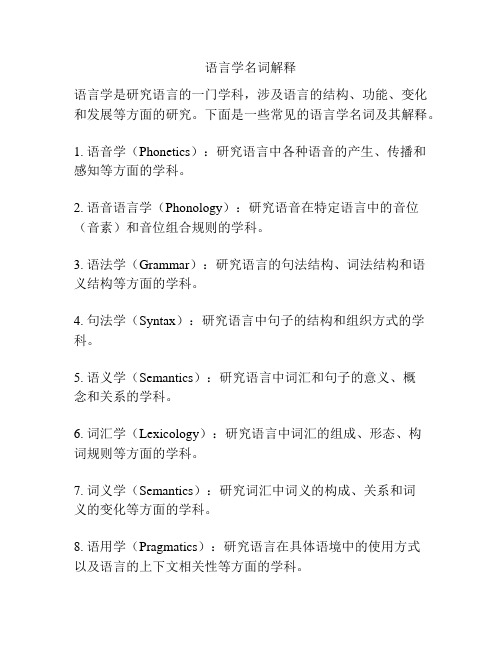
语言学名词解释语言学是研究语言的一门学科,涉及语言的结构、功能、变化和发展等方面的研究。
下面是一些常见的语言学名词及其解释。
1. 语音学(Phonetics):研究语言中各种语音的产生、传播和感知等方面的学科。
2. 语音语言学(Phonology):研究语音在特定语言中的音位(音素)和音位组合规则的学科。
3. 语法学(Grammar):研究语言的句法结构、词法结构和语义结构等方面的学科。
4. 句法学(Syntax):研究语言中句子的结构和组织方式的学科。
5. 语义学(Semantics):研究语言中词汇和句子的意义、概念和关系的学科。
6. 词汇学(Lexicology):研究语言中词汇的组成、形态、构词规则等方面的学科。
7. 词义学(Semantics):研究词汇中词义的构成、关系和词义的变化等方面的学科。
8. 语用学(Pragmatics):研究语言在具体语境中的使用方式以及语言的上下文相关性等方面的学科。
9. 文法学(Stylistics):研究语言使用中的文体、修辞手法、语言风格等方面的学科。
10. 母语(Mother tongue):一个人从小学会并用于日常交际的语言。
11. 第二语言(Second language):在学习者的母语之外学习的语言。
12. 语言接触(Language contact):不同语言之间在社会、文化接触中产生的相互影响和借用的现象。
13. 语言变异(Language variation):指同一个语言在不同社会、地理和使用者间发生的音、词、句法等方面的变化。
14. 语言变化(Language change):指语言在漫长的时间内逐渐变化和发展的过程。
15. 语言规范(Language standardization):制定和规范一个语言的正确用法、标准词汇和语法规则的过程。
16. 语言习得(Language acquisition):指儿童在自然环境中学习母语的过程。
语言学考研术语 名词解释 带解释
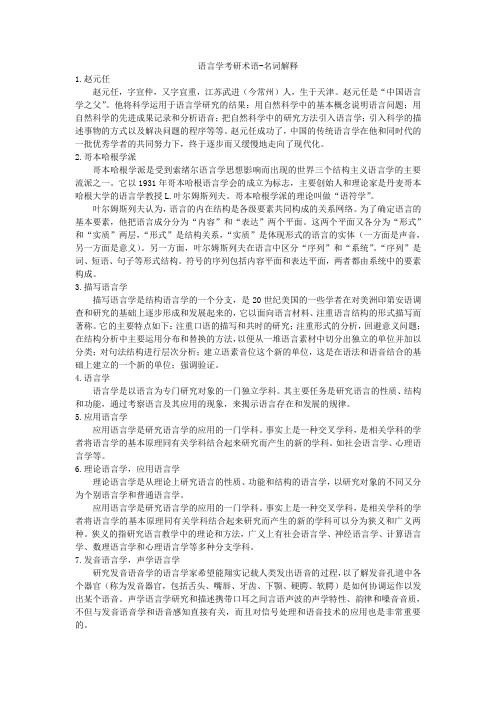
语言学考研术语-名词解释1.赵元任赵元任,字宣仲,又字宜重,江苏武进(今常州)人,生于天津。
赵元任是“中国语言学之父”。
他将科学运用于语言学研究的结果:用自然科学中的基本概念说明语言问题;用自然科学的先进成果记录和分析语音;把自然科学中的研究方法引入语言学;引入科学的描述事物的方式以及解决问题的程序等等。
赵元任成功了,中国的传统语言学在他和同时代的一批优秀学者的共同努力下,终于逐步而又缓慢地走向了现代化。
2.哥本哈根学派哥本哈根学派是受到索绪尔语言学思想影响而出现的世界三个结构主义语言学的主要流派之一。
它以1931年哥本哈根语言学会的成立为标志,主要创始人和理论家是丹麦哥本哈根大学的语言学教授L.叶尔姆斯列夫。
哥本哈根学派的理论叫做“语符学”。
叶尔姆斯列夫认为,语言的内在结构是各级要素共同构成的关系网络。
为了确定语言的基本要素,他把语言成分分为“内容”和“表达”两个平面。
这两个平面又各分为“形式”和“实质”两层,“形式”是结构关系,“实质”是体现形式的语言的实体(一方面是声音,另一方面是意义)。
另一方面,叶尔姆斯列夫在语言中区分“序列”和“系统”。
“序列”是词、短语、句子等形式结构。
符号的序列包括内容平面和表达平面,两者都由系统中的要素构成。
3.描写语言学描写语言学是结构语言学的一个分支,是20世纪美国的一些学者在对美洲印第安语调查和研究的基础上逐步形成和发展起来的,它以面向语言材料、注重语言结构的形式描写而著称。
它的主要特点如下:注重口语的描写和共时的研究;注重形式的分析,回避意义问题;在结构分析中主要运用分布和替换的方法,以便从一堆语言素材中切分出独立的单位并加以分类;对句法结构进行层次分析;建立语素音位这个新的单位,这是在语法和语音结合的基础上建立的一个新的单位;强调验证。
4.语言学语言学是以语言为专门研究对象的一门独立学科。
其主要任务是研究语言的性质、结构和功能,通过考察语言及其应用的现象,来揭示语言存在和发展的规律。
语言学教程相关名词翻译和解释
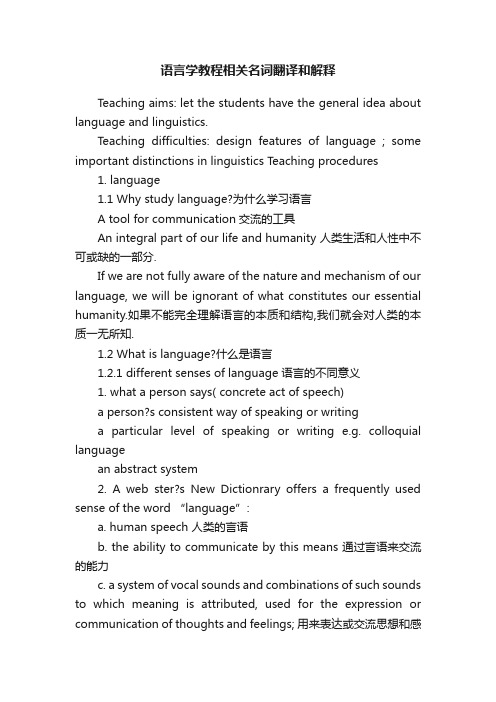
语言学教程相关名词翻译和解释Teaching aims: let the students have the general idea about language and linguistics.Teaching difficulties: design features of language ; some important distinctions in linguistics T eaching procedures1. language1.1 Why study language?为什么学习语言A tool for communication交流的工具An integral part of our life and humanity 人类生活和人性中不可或缺的一部分.If we are not fully aware of the nature and mechanism of our language, we will be ignorant of what constitutes our essential humanity.如果不能完全理解语言的本质和结构,我们就会对人类的本质一无所知.1.2 What is language?什么是语言1.2.1 different senses of language 语言的不同意义1. what a person says( concrete act of speech)a person?s consistent way of speaking or writinga particular level of speaking or writing e.g. colloquial languagean abstract system2. A web ster?s New Dictionrary offers a frequently used sense of the word “language”:a. human speech 人类的言语b. the ability to communicate by this means 通过言语来交流的能力c. a system of vocal sounds and combinations of such sounds to which meaning is attributed, used for the expression or communication of thoughts and feelings; 用来表达或交流思想和感觉的一套声音及这些声音互相结合的系统d. the written representation of such a system 系统的文字表达3. the barest of definition, language is a means of verbal communication.最简洁的定义:语言是言语交流的一种方式.Language is instrumental in that communicating by speaking or writing is a purposeful act. It is social and conventional in that language is a social semiostic and communication can only take place effectively if all the users share a broad understanding of human interaction including such associated factors as nonverbal cues, motivation, and socio-cultural roles. Language distinguishes us from animals.因为说和写的交流方式是一种有目的的行为,所以语言是实用性的;因为语言是社会符号,语言的交流只能在所有参与者广泛理解了人类的那些非言语的暗示,动机,社会文化角色等等互相关联的因素之后才能有效进行,因此语言又是社会的,约定俗成的.语言使人嗲鹩诙?1.2.2 definitions一.Language is a system of arbitrary vocal symbols used for human communication.What is communication?A process in which information is transmitted from a source (sender or speaker) to a goal (receiver or listener).A system----since elements in it are arranged according to certain rules systematically, rather than randomly. They cannot be arranged at will. e.g. He the table cleaned. (×) bkli (×) Why do we say language is arbitrary?Arbitrary----there is no intrinsic (logic) connection between a linguistic form and its meaning, between the sounds that people use and the objects to which these sounds refer. This explains and is explained by the fact that different language havedifferent words for the same object, it is good illustration of the arbitrary nature of language . it is only our tacit agreement of utterance and concept at work and not any innate relationship bound up in the utterance. A typical example to illustrate the arbitrary of language is a famous quotation from shakepeare’s play:”Romeo and Juliet: A rose by any other name would smell as sweet.一朵玫瑰不管它叫什么名字,闻起来都是一样香的.Symbols----words are just the symbols associated with objects, actions, and ideas by nothing but convention. Namely, people use the sounds or voval forms to symbolize what they wish to refer to.V ocal-------- the primary medium for all languages is sound, no matter how well developed their writing systems are. Writing systems came much later than the spoken forms. The fact that small children learn and can only learn to speak and listen before they write or read also indicates that language is primarily vocal, rather than written.Writing systems came into being much later than the spoken forms.People with little or no literacy can also be competent language users.Human ----language is human-specific.Human beings have different kinds of brains and vocal capacity.“Language Acquisition Device”(LAD)二.What characteristics of langauge do you think should be included in a good ,comprenhensive definition of language?Language is a rule-governed system; langauge is basically vocal; langauge is arbitrary ; langague is used for human communication.1.3 Design features of language 语言的结构特征Design features------ refers to the defining properties of human language that distinguish it from any animal system of communication. They are arbitrariness, duality, creativity/ productivity, displacement, clutural transmission and interchangeability.Design features----- are features that define our human languages,such as arbitrariness,duality,creativity,displacement,cultural transmission,etc.(指决定了人类语言性质的特征.例如任意性,二重性,创造性,移位性,文化转移性等.)The American linguist Charles Hockett specified twelve design features.What is arbitrariness?任意性a. arbitrariness---- arbitrariness(任意性): one design feature of human language,which refers to the fact that the forms of linguistic signs bear no natural relationship to their meaning.(人类语言的本质特征之一,指语言符号的形式与意义之间没有自然的联系.) It was discussed by Saussure first.The link between them is a matter of convention.E.g. “house” uchi (Japanese)Mansion (French)房子(Chinese)(1) arbitrary between the sound of a morpheme and its meaning语言的音和义之间的任意性a. By “arbitrary”, we mean there is no logical connection between meanings and sounds. 语言的意义和语音之间没有逻辑关系。
(完整word版)语言学 术语翻译及术语解释
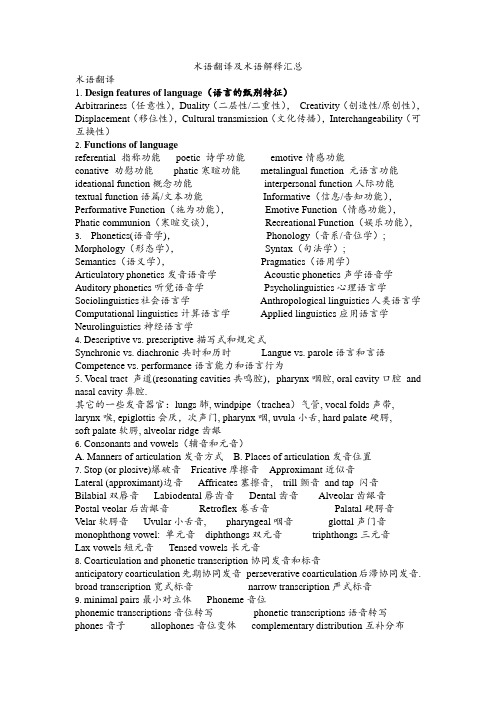
术语翻译及术语解释汇总术语翻译1.Design features of language(语言的甄别特征)Arbitrariness(任意性),Duality(二层性/二重性),Creativity(创造性/原创性),Displacement(移位性),Cultural transmission(文化传播),Interchangeability(可互换性)2. Functions of languagereferential 指称功能poetic 诗学功能emotive情感功能conative 劝慰功能phatic寒暄功能metalingual function 元语言功能ideational function概念功能interpersonal function人际功能textual function语篇/文本功能Informative(信息/告知功能),Performative Function(施为功能),Emotive Function(情感功能),Phatic communion(寒暄交谈),Recreational Function(娱乐功能),3. Phonetics(语音学),Phonology(音系/音位学); Morphology(形态学),Syntax(句法学);Semantics(语义学),Pragmatics(语用学)Articulatory phonetics发音语音学Acoustic phonetics声学语音学Auditory phonetics听觉语音学Psycholinguistics心理语言学Sociolinguistics社会语言学Anthropological linguistics人类语言学Computational linguistics计算语言学Applied linguistics应用语言学Neurolinguistics神经语言学4. Descriptive vs. prescriptive描写式和规定式Synchronic vs. diachronic共时和历时Langue vs. parole语言和言语Competence vs. performance语言能力和语言行为5. V ocal tract 声道(resonating cavities共鸣腔),pharynx咽腔, oral cavity口腔and nasal cavity鼻腔.其它的一些发音器官:lungs肺, windpipe(trachea)气管, vocal folds声带, larynx喉, epiglottis会厌,次声门, pharynx咽, uvula小舌, hard palate硬腭,soft palate软腭, alveolar ridge齿龈6.Consonants and vowels(辅音和元音)A. Manners of articulation发音方式B. Places of articulation发音位置7. Stop (or plosive)爆破音Fricative摩擦音Approximant近似音Lateral (approximant)边音Affricates塞擦音, trill颤音and tap 闪音Bilabial双唇音Labiodental唇齿音Dental齿音Alveolar齿龈音Postal veolar后齿龈音Retroflex卷舌音Palatal硬腭音Velar软腭音Uvular小舌音, pharyngeal咽音glottal声门音monophthong vowel: 单元音diphthongs双元音triphthongs三元音Lax vowels短元音Tensed vowels长元音8.Coarticulation and phonetic transcription协同发音和标音anticipatory coarticulation先期协同发音perseverative coarticulation后滞协同发音. broad transcription宽式标音narrow transcription严式标音9. minimal pairs最小对立体Phoneme音位phonemic transcriptions音位转写phonetic transcriptions语音转写phones音子allophones音位变体complementary distribution互补分布phonetic similarity发音近似性Free variation自由变体assimilation同化regressive assimilation逆同化progressive assimilation顺同化phonological rule 音系规则Epenthesis增音binary 二分的Distinctive features区别特征Endocentric and Exocentric Constructions向心结构和离心结构subordinate and coordinate从属和并列Conceptual meaning概念意义Associative meaning:联想意义Connotative meaning内涵意义Social meaning社会意义Affective meaning情感意义Reflected meaning反射意义Collocative meaning搭配意义Thematic meaning主位意义denotation: 外延意义connotation: 内涵The referential theory:指称理论Semantic triangle语义三角Sense and reference:涵义和指称Synonymy同义关系Antonymy反义关系Hyponymy上下义关系Polysemy一词多义关系Homonymy 同音/形异意关系Dialectal synonyms 地域同义词Stylistic synonyms风格同义词Collocational synonyms搭配同义词gradable antonymy 等级反义关系cover term覆盖项Marked vs. unmarked terms标记项和非标记项complementary antonymy 互补反义关系converse antonymy 逆向反义关系homophones: 同音异义词homographs : 同形异义词complete homonyms semantic components语义部分术语解释1.Design feature的定义:the defining(最典型的,起决定作用的)properties ofhuman language that distinguish it from any animal system of communication. 2.Synchronic共时:It refers to the description of a language at some point of timein history.3.Diachronic历时:It studies the development or history of language. In otherwords, it refers to the description of a language as it changes through time .4.prescriptive规定式:A kind of linguistic s tudy aims to lay down rules for “correctand standard” behavior in using language.5.descriptive描写式: A kind of linguistic study aims to describe and analyze thelanguage people actually use.6.Arbitrariness(任意性):By saying that “language is arbitrary”, we mean thatthere is no logical connection between meaning and sound.7.Duality(二层性/二重性):it means that language is a system, which consists oftwo levels of structures, at the lower level there is the structure of sounds; at the higher level there is the structure of meaning.8.Displacement(移位性): it means that language can be used to communicateabout things that are not present in our immediate communicational context.petence语言能力:it refers to an ideal speaker’s knowledge of the underlyingsystem of rules in a language.10.Performance语言行为: it refers to the actual use of the language by a speaker ina real communicational context.ngue语言: it refers to the speaker’s understanding and knowledge of thelanguage that he speaks.12.Parole言语: it is the actual speaking of language by an individual speaker.13.Cultural transmission(文化传播):It refers to the fact that the details of thelinguistic system must be learned anew(重新,再)by each speaker. Language is not transmitted biologically from generation to generation.14.Phatic communion(寒暄交谈):it refers to ritual exchanges, exchanges that havelittle meaning but help to maintain our relationships with other people.15.Phonetics(语音学): it is the study of the characteristics of speech sounds andprovides methods for their description, classification and transcription.16.V owels元音:the sounds in the production of which no articulators come veryclose together and the air-stream passes through the vocal tract without obstruction.17.Consonants辅音:The sounds in the production of which there is an obstructionof the air-stream at some point of the vocal tract.18.Phonology: it is the study of the sound systems of languages and it is concernedwith the linguistic patterning of sounds in human languages. And it studies the way in which speakers of a language systematically use a selection of these sounds in order to express meaning.19.Phoneme音位: the smallest unit of sound in a language which can distinguish twowords.20.Allophone音位变体: it refers to the different forms of a phoneme.21.Assimilation: it is a process by which one sound takes on some or all thecharacteristics of a neighboring sound.22.Coarticulation: a kind of phonetic process in which simultaneous or overlappingarticulations are involved.plementary distribution互补分布:when two sounds never occur in thesame environment, they are in complementary distribution.24.Free variation自由变体: if two sounds occurring in the same environment do notcontrast, that is, the substitution of one for the other does not produce a different word form, but merely a different pronunciation of the same word, then the two sounds are in free variation.25.Distinctive features区别特征:A phonetic feature which distinguishes onephonological unit, especially one phoneme, from another.26.minimal pairs最小对立体----- which can be defined as pairs of words whichdiffer from each other by only one sound.27.vowel glides滑音: The vowels involving movement from one sound to anotherare called vowel glides.28.Epenthesis增音:it means a process of inserting a sound after another sound.29.Substitution relation: it refers to the relation specifically between an individualunit and others that can replace it in a given sequence.30.Endocentric construction is one whose distribution is functionally equivalent, orapproaching equivalence, to one of its constituents, which serves as the centre, or head, of the whole.31.Exocentric construction: a group of syntactically related words where none ofthem is functionally equivalent to the group as a whole, that is, there is no definable center or head inside the group32.Reference: it is the relationship between words and the objects, actions orproperties that the words stand for. It deals with the extra-linguistic relationships between words and expressions and the world they describe.(具体的物质性的东西)33.Synonymy :It refers to the sameness sense relations between words.ponential analysis :Componential analysis defines the meaning of alexical element in terms of semantic components语义部分.35.Sense: it refers to the complex system of relationships that hold between linguisticelements themselves, it is concerned only with intra-linguistic relations.(概念性的东西)36.Semantics:semantics is the study of the meaning of linguistic units, words andsentences in particular.37.Homonymy: the phenomenon that words having different meanings have the sameform, i.e., different words are identical in sound or spelling, or in both.38.Antonymy:It refers to the oppositeness sense relations between words.39.Hyponymy上下义关系:Hyponymy indicates sense inclusiveness. The upperterm in this sense relation is called superordinate上义词,and the lower terms, hyponyms下义词, members of the same class are called co-hyponyms.。
语言学名词解释

(一)名词解释1. 语言学: 语言学是以人类语言作为研究对象的学科, 研究人类语言的性质、结构、发展及其在社会生活中的运用以及语言研究成果的应用问题, 等等。
分理论语言学和应用语言学两个领域。
2. “小学”: 在中国古代, 小学先从教授字的形(六书)、音、义开始, 就把研究文字、训诂、音韵方面的学问统称为小学。
小学一直是经学的一部分, 包括音韵学、训诂学、文字学三个分支学科。
3.非语言交际工具或副语言交际工具: 人们在运用语言进行交际的时候, 不但动嘴, 而且脸部的表情、手的动作、乃至整个躯体的姿态等非语言的东西也都参加进来。
我们这些非语言的交际工具称为副语言交际工具。
副语言交际工具的使用范围非常有限, 只能起辅助性的交际作用, 以补充语言交际的某些不足。
4.辅助性交际工具: 指的文字、旗语、电报代码等在语言的基础上产生的交际工具。
这些交际工具若离开语言就不能独立存在。
其特点是: 都有特殊的服务领域, 使用的范围相当狭窄。
5.符号:符号, 就是指代某种事物的标记, 记号, 它是由一个社会的全体成员共同约定用来表示某种意义的标记和记号。
6.符号的任意性:任意性是语言符号的本质特征之一。
其含义是:语言符号的音义联系并非是本质的, 必然的, 而是由社会成员共同约定的, 一种意义为什么要用这个声音形式, 而不用那种声音形式, 这中间没有什么道理可言, 完全是偶然的、任意的。
语言符号和客观事物之间也没有必然联系。
7.语言符号: 特定语言系统中作为音义结合体的语言单位称为语言符号。
与一般符号相比, 语言符号的主要特点是: 音义结合的任意性、能指的线性特征、所指组合的层次性等等。
8.语言的层级体系: 语言的层级体系: 语言的底层是一套音位, 一种语言的音位的数目虽然只有几十个, 却能构成数目众多的组合。
这些组合为语言符号准备了形式的部分。
语言的上层是音义结合的符号和符号的序列, 这一层又分为若干级。
第一级是语素, 意义在这里被装进形式的口袋, 成了音义结合的最小的符号。
考研资料语言学名词解释汇总

考研资料语言学名词解释汇总在考研的漫漫征途中,语言学是众多考生需要攻克的重要堡垒之一。
而理解和掌握一系列关键的语言学名词,是构建扎实知识体系的基石。
以下为大家汇总了一些常见且重要的语言学名词解释,希望能为您的考研之路助力。
一、语音学(Phonetics)语音学是研究人类语言声音的学科,它关注语音的产生、传播和感知。
具体包括发音语音学(Articulatory Phonetics),研究发音器官如何产生语音;声学语音学(Acoustic Phonetics),探讨语音的声学特征;听觉语音学(Auditory Phonetics),关注人类如何感知语音。
例如,元音(Vowel)和辅音(Consonant)是语音学中的重要概念。
元音是在发音过程中气流不受阻碍发出的音,其音质较为清晰、响亮;辅音则是气流在发音器官的某一部分受到阻碍而发出的音。
二、音系学(Phonology)音系学研究的是语言中的语音系统和模式,关注语音在特定语言中的功能和组织方式。
例如,音位(Phoneme)是能够区别意义的最小语音单位。
在英语中,“pat”和“bat”中的“p”和“b”就是不同的音位,因为它们的替换会导致词义的改变。
三、形态学(Morphology)形态学主要研究词的内部结构和构词规则。
比如,词根(Root)是词的基本部分,承载着主要的词汇意义。
例如,“happy”中的“hap”就是词根。
词缀(Affix)则是加在词根上以改变词义或词性的部分,分为前缀(Prefix)和后缀(Suffix)。
像“unhappy”中的“un”就是前缀。
四、句法学(Syntax)句法学关注句子的结构和组成规则。
比如,句子成分包括主语(Subject)、谓语(Predicate)、宾语(Object)等。
主语通常是句子中表示动作的执行者或主体;谓语则是表达主语的动作或状态;宾语是动作的对象。
五、语义学(Semantics)语义学研究语言符号(词、短语、句子等)与它们所指称的对象之间的关系,即语言的意义。
语言学重要概念梳理(中英文对照版)

语⾔学重要概念梳理(中英⽂对照版)第⼀节语⾔的本质⼀、语⾔的普遍特征(Design Features)1.任意性 Arbitratriness:shu 和Tree都能表⽰“树”这⼀概念;同样的声⾳,各国不同的表达⽅式2.双层结构Duality:语⾔由声⾳结构和意义结构组成(the structure ofsounds and meaning)3.多产性productive: 语⾔可以理解并创造⽆限数量的新句⼦,是由双层结构造成的结果(Understand and create unlimited number withsentences)4.移位性 Displacemennt:可以表达许多不在场的东西,如过去的经历、将来可能发⽣的事情,或者表达根本不存在的东西等5.⽂化传播性 Cultural Transmission:语⾔需要后天在特定⽂化环境中掌握⼆、语⾔的功能(Functions of Language)1.传达信息功能 Informative:最主要功能The main function2.⼈际功能 Interpersonal:⼈类在社会中建⽴并维持各⾃地位的功能establish and maintain their identity3.⾏事功能 performative:现实应⽤——判刑、咒语、为船命名等Judge,naming,and curses4.表情功能 Emotive Function:表达强烈情感的语⾔,如感叹词/句exclamatory expressions5.寒暄功能 Phatic Communion:应酬话phatic language,⽐如“吃了没?”“天⼉真好啊!”等等6.元语⾔功能 Metalingual Function:⽤语⾔来谈论、改变语⾔本⾝,如book可以指现实中的书也可以⽤“book这个词来表达作为语⾔单位的“书”三、语⾔学的分⽀1. 核⼼语⾔学 Core linguistic1)语⾳学 Phonetics:关注语⾳的产⽣、传播和接受过程,着重考察⼈类语⾔中的单⾳。
语言学重要概念梳理(中英文对照版)

第一节语言的本质一、语言的普遍特征(Design Features)1.任意性 Arbitratriness:shu 和Tree都能表示“树”这一概念;同样的声音,各国不同的表达方式2.双层结构Duality:语言由声音结构和意义结构组成(the structure ofsounds and meaning)3.多产性productive: 语言可以理解并创造无限数量的新句子,是由双层结构造成的结果(Understand and create unlimited number withsentences)4.移位性 Displacemennt:可以表达许多不在场的东西,如过去的经历、将来可能发生的事情,或者表达根本不存在的东西等5.文化传播性 Cultural Transmission:语言需要后天在特定文化环境中掌握二、语言的功能(Functions of Language)1.传达信息功能 Informative:最主要功能The main function2.人际功能 Interpersonal:人类在社会中建立并维持各自地位的功能establish and maintain their identity3.行事功能 performative:现实应用——判刑、咒语、为船命名等Judge,naming,and curses4.表情功能 Emotive Function:表达强烈情感的语言,如感叹词/句exclamatory expressions5.寒暄功能 Phatic Communion:应酬话phatic language,比如“吃了没?”“天儿真好啊!”等等6.元语言功能 Metalingual Function:用语言来谈论、改变语言本身,如book可以指现实中的书也可以用“book这个词来表达作为语言单位的“书”三、语言学的分支1. 核心语言学 Core linguistic1)语音学 Phonetics:关注语音的产生、传播和接受过程,着重考察人类语言中的单音。
语言学术语

语言学术语介绍本文档旨在介绍一些常见的语言学术语,以帮助读者更好地理解语言学领域的相关概念和术语。
术语解释以下是一些常见的语言学术语及其解释:1. 语言学:语言学是研究语言的科学。
它涵盖了语言的结构、历史、使用和变化等方面。
语言学:语言学是研究语言的科学。
它涵盖了语言的结构、历史、使用和变化等方面。
2. 语音学:语音学是研究语音的学科,它关注语音的产生、传播和感知。
语音学:语音学是研究语音的学科,它关注语音的产生、传播和感知。
3. 语法:语法是研究句子结构和语法规则的学科。
它涉及词类、短语和句子的形成和组织。
语法:语法是研究句子结构和语法规则的学科。
它涉及词类、短语和句子的形成和组织。
4. 词汇学:词汇学是研究词汇的学科。
它关注词汇的构成、意义和使用。
词汇学:词汇学是研究词汇的学科。
它关注词汇的构成、意义和使用。
5. 句法学:句法学是研究句子结构和句法关系的学科。
它探讨句子中词汇和短语的排列和组合方式。
句法学:句法学是研究句子结构和句法关系的学科。
它探讨句子中词汇和短语的排列和组合方式。
6. 语义学:语义学是研究语义(意义)的学科,它涉及词汇和句子意义的形成和解释。
语义学:语义学是研究语义(意义)的学科,它涉及词汇和句子意义的形成和解释。
7. 语用学:语用学是研究语言使用情境和交际的学科。
它关注语言在特定情境中的意义和目的。
语用学:语用学是研究语言使用情境和交际的学科。
它关注语言在特定情境中的意义和目的。
8. 语音:语音是指语言中的声音单元。
它包括语音音素、音节和音调等。
语音:语音是指语言中的声音单元。
它包括语音音素、音节和音调等。
9. 音标:音标是用来表示语音的符号系统。
它可以用来记录和描述各种语音发音。
音标:音标是用来表示语音的符号系统。
它可以用来记录和描述各种语音发音。
10. 文字:文字是指用来书写语言的符号系统。
不同语言使用不同的文字系统。
文字:文字是指用来书写语言的符号系统。
不同语言使用不同的文字系统。
语言学重要概念梳理中英文对照版
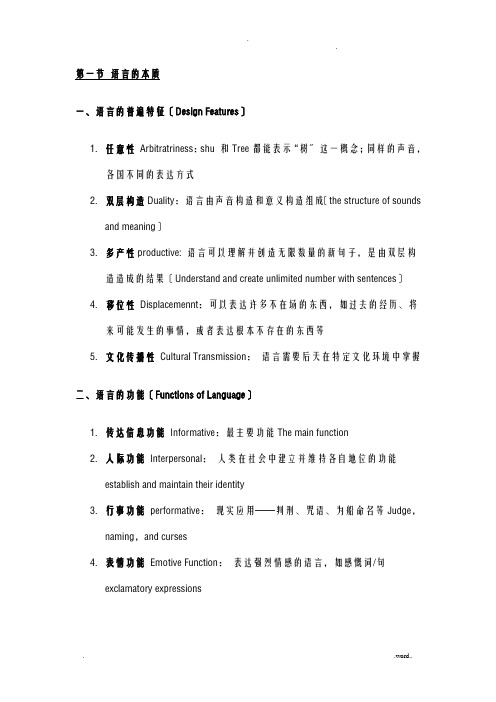
第一节语言的本质一、语言的普遍特征〔Design Features〕1.任意性Arbitratriness:shu 和Tree都能表示“树〞这一概念;同样的声音,各国不同的表达方式2.双层构造Duality:语言由声音构造和意义构造组成〔the structure of soundsand meaning〕3.多产性productive: 语言可以理解并创造无限数量的新句子,是由双层构造造成的结果〔Understand and create unlimited number with sentences〕4.移位性Displacemennt:可以表达许多不在场的东西,如过去的经历、将来可能发生的事情,或者表达根本不存在的东西等5.文化传播性Cultural Transmission:语言需要后天在特定文化环境中掌握二、语言的功能〔Functions of Language〕1.传达信息功能Informative:最主要功能The main function2.人际功能Interpersonal:人类在社会中建立并维持各自地位的功能establish and maintain their identity3.行事功能performative:现实应用——判刑、咒语、为船命名等Judge,naming,and curses4.表情功能Emotive Function:表达强烈情感的语言,如感慨词/句exclamatory expressions5.应酬功能Phatic munion:应酬话phatic language,比方“吃了没?〞“天儿真好啊!〞等等6.元语言功能Metalingual Function:用语言来谈论、改变语言本身,如book可以指现实中的书也可以用“book这个词来表达作为语言单位的“书〞三、语言学的分支1. 核心语言学Core linguistic1)语音学Phonetics:关注语音的产生、传播和承受过程,着重考察人类语言中的单音。
《语言学》术语及英文解释
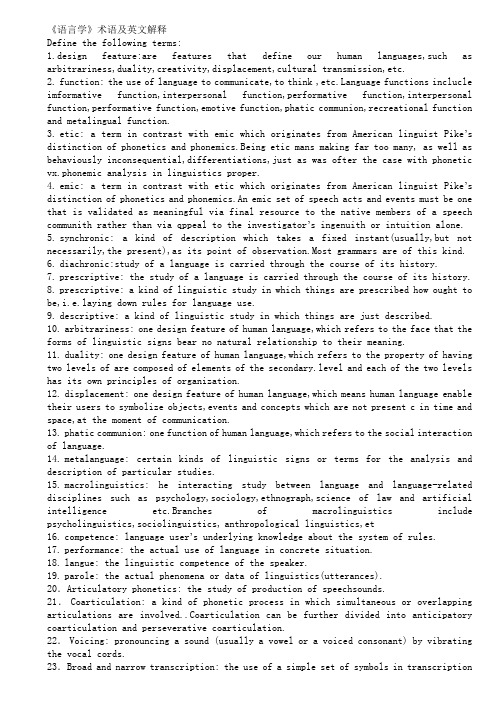
《语言学》术语及英文解释Define the following terms:1.design feature:are features that define our human languages,such as arbitrariness,duality,creativity,displacement,cultural transmission,etc.2.function: the use of language to communicate,to think ,nguage functions inclucle imformative function,interpersonal function,performative function,interpersonal function,performative function,emotive function,phatic communion,recreational function and metalingual function.3.etic: a term in contrast with emic which originates from American linguist Pike’s distinction of phonetics and phonemics.Being etic mans making far too many, as well as behaviously inconsequential,differentiations,just as was ofter the case with phonetic vx.phonemic analysis in linguistics proper.4.emic: a term in contrast with etic which originates from American linguist Pike’s distinction of phonetics and phonemics.An emic set of speech acts and events must be one that is validated as meaningful via final resource to the native members of a speech communith rather than via qppeal to the investigator’s ingenuith or intuition alone.5.synchronic: a kind of description which takes a fixed instant(usually,but not necessarily,the present),as its point of observation.Most grammars are of this kind.6.diachronic:study of a language is carried through the course of its history.7.prescriptive: the study of a language is carried through the course of its history.8.prescriptive: a kind of linguistic study in which things are prescribed how ought to be,ying down rules for language use.9.descriptive: a kind of linguistic study in which things are just described.10.arbitrariness: one design feature of human language,which refers to the face that the forms of linguistic signs bear no natural relationship to their meaning.11.duality: one design feature of human language,which refers to the property of having two levels of are composed of elements of the secondary.level and each of the two levels has its own principles of organization.12.displacement: one design feature of human language,which means human language enable their users to symbolize objects,events and concepts which are not present c in time and space,at the moment of communication.13.phatic communion: one function of human language,which refers to the social interaction of language.14.metalanguage: certain kinds of linguistic signs or terms for the analysis and description of particular studies.15.macrolinguistics: he interacting study between language and language-related disciplines such as psychology,sociology,ethnograph,science of law and artificial intelligence etc.Branches of macrolinguistics include psycholinguistics,sociolinguistics,anthropological linguistics,etpetence: language user’s underlying knowledge about the system of rules.17.performance: the actual use of language in concrete situation.ngue: the linguistic competence of the speaker.19.parole: the actual phenomena or data of linguistics(utterances).20.Articulatory phonetics: the study of production of speechsounds. 21.Coarticulation: a kind of phonetic process in which simultaneous or overlapping articulations are involved..Coarticulation can be further divided into anticipatory coarticulation and perseverative coarticulation.22.Voicing: pronouncing a sound (usually a vowel or a voiced consonant) by vibrating the vocal cords.23.Broad and narrow transcription: the use of a simple set of symbols in transcriptionis called broad transcription;the use of a simple set of symbols in transcription is called broad transcription;while,the use of more specific symbols to show more phonetic detail is referred to as narrow transcription.24. Consonant: are sound segments produced by constricting or obstructing the vocal tract at some place to divert,impede,or completely shut off the flow of air in the oral cavity. 25.Phoneme: the abstract element of sound, identified as being distinctive in a particular language.26.Allophone:any of the different forms of a phoneme(eg.<th>is an allophone of /t/in English.When /t/occurs in words like step,it is unaspirated<t>.Both<th>and <t>are allophones of the phoneme/t/.27.Vowl:are sound segments produced without such obstruction,so no turbulence of a total stopping of the air can be perceived.28.Manner of articulation; in the production of consonants,manner of articulation refers to the actual relationship between the articulators and thus the way in which the air passes through certain parts of the vocal tract.29.Place of articulation: in the production of consonants,place of articulation refers to where in the vocal tract there is approximation,narrowing,or the obstruction of air. 30.Distinctive features: a term of phonology,i.e.a property which distinguishes one phoneme from another.31.Complementary distribution: the relation between tow speech sounds that never occur in the same environment.Allophones of the same phoneme are usually in complementary distribution.32.IPA: the abbreviation of International Phonetic Alphabet,which is devised by the International Phonetic Association in 1888 then it has undergong a number of revisions.IPA is a comprised system employing symbols of all sources,such as Roman small letters,italics uprighted,obsolete letters,Greek letters,diacritics,etc.33.Suprasegmental:suprasegmental featuresare those aspects of speech that involve more than single sound segments.The principal supra-segmental features aresyllable,stress,tone,,and intonation.34.Suprasegmental:aspects of speech that involve more than single sound segments.The principle suprasegmental features are syllable,stress,tone,and intonation.35.morpheme:the smallest unit of language in terms of relationship between expression and content,a unit that cannot be divided into further small units without destroying or drastically altering the meaning,whether it is lexical or grammatical.poundoly morphemic words which consist wholly of free morphemes,such as classroom,blackboard,snowwhite,etc.37.inflection: the manifestation of grammatical relationship through the addition of inflectional affixes,such as number,person,finiteness,aspect and case,which do not change the grammatical class of the stems to which they are attached.38.affix: the collective term for the type of formative that can be used only when added to another morpheme(the root or stem).39.derivation: different from compounds,derivation shows the relation between roots and affixes.40.root: the base from of a word that cannot further be analyzed without total lass of identity.41.allomorph:; any of the different form of a morpheme.For example,in English the plural mortheme is but it is pronounced differently in different environments as/s/in cats,as/z/ in dogs and as/iz/ in classes.So/s/,/z/,and /iz/ are all allomorphs of the plural morpheme.42.Stem: any morpheme or combination of morphemes to which an inflectional affix can be added.43.bound morpheme: an element of meaning which is structurally dependent on the world it is added to,e.g. the plural morpheme in “dog’s”.44.free morpheme: an element of meaning which takes the form of an independent word.45.lexeme:A separate unit of meaning,usually in the form of a word(e.g.”dog in the manger”)46.lexicon: a list of all the words in a language assigned to various lexical categories and provided with semantic interpretation.47.grammatical word: word expressing grammatical meanings,such conjunction,prepositions,articles and pronouns.48.lexical word: word having lexical meanings,that is ,those which refer to substance,action and quality,such as nouns,verbs,adjectives,and verbs.49.open-class: a word whose membership is in principle infinite or unlimited,such as nouns,verbs,adjectives,and many adverbs.50.blending: a relatively complex form of compounding,in which two words are blended by joining the initial part of the first word and the final part of the second word,or by joining the initial parts of the two words.术语251.loanvoord: a process in which both form and meaning are borrowed with only a slight adaptation,in some cases,to eh phonological system of the new language that they enter.52.loanblend: a process in which part of the form is native and part is borrowed, but the meaning is fully borrowed.53.leanshift: a process in which the meaning is borrowed,but the form is native.54.acronym: is made up form the first letters of the name of an organization,which hasa heavily modified headword.55.loss: the disappearance of the very sound as a morpheme in the phonological system.56.back-formation: an abnormal type of word-formation where a shorter word is derived by deleting an imagined affix from a long form already in the language.57.assimilation: the change of a sound as a result of the influence of an adjacent sound,which is more specifically called.”contact”or”contiguous”assimilation.58.dissimilation: the influence exercised.By one sound segment upon the articulation of another, so that the sounds become less alike,or different.59.folk etymology: a change in form of a word or phrase,resulting from an incorrect popular nation of the origin or meaning of the term or from the influence of more familiar terms mistakenly taken to be analogous60.category:parts of speech and function,such as the classification of words in terms of parts of speech,the identification of terms of parts of speech,the identification of functions of words in term of subject,predicate,etc.61.concord: also known as agreement,is the requirement that the forms of two or more words in a syntactic relationship should agree with each other in terms of some categories.62.syntagmatic relation between one item and others in a sequence,or between elements which are all present.63.paradigmatic relation: a relation holding between elements replaceable with each other at a particular place in a structure,or between one element present and he others absent.64.immediate constituent analysis: the analysis of a sentence in terms of its immediate constituents---word groups(or phrases),which are in trun analyzed into the immediate constituents of their own,and the process goes on until the ultimate constituents are reached.65.endocentric construction: one construction whose distribution is functionally equivalent,or approaching equivalence,to one of its constituents,which serves as the centre,or head, of the whole.Hence an endocentric construction is also known as a headed construction.66.exocentric construction: a construction whose distribution is not functionally equivalent to any to any of its constituents.67.deep structure: the abstract representation of the syntactic properties of a construction,i.e.the underlying level of structural relations between its different constituents ,such sa the relation between,the underlying subject and its verb,or a verb and its object.68.surfacte structure: the final stage in the syntactic derivation of a construction,which closely corresponds to the structural organization of a construction people actually produce and receive.69.c-command: one of the similarities,or of the more general features, in these two government relations,is technically called constituent command,c-command for short. ernment and binding theory: it is the fourth period of development Chomsky’s TG Grammar, which consists of X-bar theme: the basis,or the starting point,of the utterance.municative dynamism: the extent to which the sentence element contributes to the development of the communication.72.ideational function: the speaker’s experience of the real world,including the inner world of his own consciousness.73.interpersonal function: the use of language to establish and maintain social relations: for the expression of social roles,which include the communication roles created by language itself;and also for getting things done,by means of the interaction between one person and another..74.textual function: the use of language the provide for making links with itself and with features of the situation in which it is used.75.conceptual meaning: the central part of meaning, which contains logical,cognitive,or denotative content.76.denotation: the core sense of a word or a phrade that relates it to phenomena in the real world.77.connotation: a term in a contrast with denotation,meaning the properties of the entitya word denotes.78.reference: the use of language to express a propostion,meaning the properties of the entity a word denotes.79.reference: the use of anguage to express a proposition,i.e. to talk about things in context.80.sense: the literal meaning of a word or an expression,independent of situational context.81.synonymy: is the technical name for the sameness relation.plentary antonymy: members of a pair in complementary antonymy are complementary to each field completely,such as male,female,absent.83.gradable antongymy: members of this kind are gradable,such as long:short,big;small,fat;thin,etc.84.converse antonymy: a special kind of antonymy in that memembers of a pair do not constitute a positive-negative opposition,such as buy;sell,lend,borrow,above,below,etc.85.relational opposites:converse antonymy in reciprocal social roles,kinship relations,temporal and spatial relations.There are always two entities involved.One presupposes the other. The shorter,better;worse.etc are instances of relational opposites.86.hyponymy: a relation between tow words,in which the meaning of one word(the superordinate)is included in the meaning of another word(the hyponym)87.superordinate: the upper term in hyponymy,i.e.the class name.A superordinate usually has several hyponyms.Under animal,for example,there are cats,dogs,pigs,etc,88.semantic component: a distinguishable element of meaning in a word with twovalues,e.g<+human>positionality: a principle for sentence analysis, in which the meaning of a sentence depends on the meanings of the constituent words and the way they are combined.90.selection restriction:semantic restrictions of the noun phrases that a particular lexical item can take,e.g.regret requires a human subject.91.prepositional logic: also known as prepositional calculus or sentential calculus,is the study of the truth conditions for propositions:how the truth of a composite propositions and the connection between them.92.proposition;what is talk about in an utterance,that part of the speech act which has to do with reference.93.predicate logic: also predicate calculus,which studies the internal structure of simple.94.assimilation theory: language(sound,word,syntax,etc)change or process by which features of one element change to match those of another that precedes or follows. 95.cohort theory: theory of the perception of spoken words proposed in the mid-1980s.It saaumes a “recognition lexicon”in which each word is represented by a full and independent”recognistion element”.When the system receives the beginning of a relevant acoustic signal,all elements matching it are fully acticated,and,as more of the signal is received,the system tries to match it independently with each of them,Wherever it fails the element is deactivated;this process continues until only one remains active.96.context effect: this effect help people recognize a word more readily when the receding words provide an appropriate context for it.97. frequency effect: describes the additional ease with which a word is accessed due to its more frequent usage in language.98.inference in context: any conclusion drawn from a set of proposition,from something someone has said,and so on.It includes things that,while not following logically,are implied,in an ordinary sense,e.g.in a specific context.99.immediate assumption: the reader is supposed to carry out the progresses required to understand each word and its relationship to previous words in the sentence as soon as that word in encountered.nguage perception:language awareness of things through the physical senses,esp,sight.术语3nguage comprehension: one of the three strand of psycholinguistic research,which studies the understanding of language.nguage production: a goal-directed activety,in the sense that people speak and write in orde to make friends,influence people,convey information and so on.nguage production: a goal-directed activity,in the sense that people speak and write in order to make friends,influence people,concey information and so on.104.lexical ambiguity:ambiguity explained by reference to lexical meanings:e.g.that of I saw a bat,where a bat might refer to an animal or,among others,stable tennis bat. 105.macroproposition:general propositions used to form an overall macrostructure of the story.106.modular:which a assumes that the mind is structuied into separate modules or components,each governed by its own principles and operating independently of others. 107.parsing:the task of assigning words to parts of speech with their appropriate accidents,traditionally e.g.to pupils learning lat in grammar.108.propositions:whatever is seen as expressed by a sentence which makes a statement.It is a property of propositions that they have truth values.109.psycholinguistics: is concerned primarily with investigating the psychologicalreality of linguistic structure.Psycholinguistics can be divided into cognitive psycholing uistics(being concerned above all with making inferences about the content of human mind,and experimental psycholinguistics(being concerned somehow whth empirical matters,such as speed of response to a particular word).110.psycholinguistic reality: the reality of grammar,etc.as a purported account of structures represented in the mind of a speaker.Often opposed,in discussion of the merits of alternative grammars,to criteria of simplicity,elegance,and internal consistency. 111.schemata in text: packets of stored knowledge in language processing.112.story structure: the way in which various parts of story are arranged or organized. 113.writing process: a series of actions or events that are part of a writing or continuing developmeng.municative competence: a speaker’s knowledge of the total set of rules,conventions,erning the skilled use of language in a society.Distinguished by D.Hymes in the late 1960s from Chomsley’s concept of competence,in the restricted sense of knowledge of a grammar.115.gender difference: a difference in a speech between men and women is”genden difference”116.linguistic determinism: one of the two points in Sapir-Whorf hypothesis,nguage determines thought.117.linguistic relativity: one of the two points in Spir-Whorf hypotheis,i.e.there’s no limit to the structural diversity of languages.118.linguistic sexism:many differences between me and women in language use are brought about by nothing less than women’s place in society.119.sociolinguistics of language: one of the two things in sociolinguistics,in which we want to look at structural things by paying attention to language use in a social context. 120.sociolinguistics of society;one of the two things in sociolinguistics,in which we try to understand sociological things of society by examining linguistic phenomena of a speaking community.121.variationist linguistics: a branch of linguistics,which studies the relationship between speakers’social starts and phonological variations.122.performative: an utterance by which a speaker does something does something,as apposed to a constative,by which makes a statement which may be true or false.123.constative: an utterance by which a speaker expresses a proposition which may be true or false.124.locutionary act: the act of saying something;it’s an act of conveying literal meaning by means of syntax,lexicon,and ly.,the utterance of a sentence with determinate sense and reference.125.illocutionary act: the act performed in saying something;its force is identical with the speaker’s intention.126.perlocutionary act: the act performed by or resulting from saying something,it’s the consequence of,or the change brought about by the utterance.127.conversational implicature: the extra meaning not contained in the literal utterances,underatandable to the listener only when he shares the speaker’s knowledge or knows why and how he violates intentionally one of the four maxims of the cooperative principle.128.entailment:relation between propositions one of which necessarily follows from the other:e.g.”Mary is running”entails,among other things,”Mary is not standing still”. 129.ostensive communication: a complete characterization of communication is that it is ostensive-infer-ential.municative principle of relevance:every act of ostensive communicationcommunicates the presumption of its own optimal relevance.131.relevance: a property that any utterance,or a proposition that it communicates,must,in the nature of communication,necessarily have.132.Q-principle: one of the two principles in Horn’s scale,i.e.Make your contribution necessary (G.Relation,Quantity2,Manner);Say no more than you must(given Q).133.division of pragmatic labour: the use of a marked crelatively complex and/or expression when a corresponding unmarkeda(simpler,less”effortful”)alternate expression is available tends to be interpreted as conveying a marked message(one which the unmarked alternative would not or could not have conveyed).134.constraints on Horn scales:the hearer-based o-Principle is a sufficiency condition in the sense that information provided is the most the speaker is able to..135.third-person narrator: of the narrator is not a character in the fictional world,he or she is usually called a third –person narrator.136.I-narrator: the person who tells the story may also be a character in the fictional world of the story,relating the story after the event.137.direct speech: a kind of speech presentation in which the character said in its fullest form.138.indirect speech: a kind of speech presentation in which the character said in its fullest form.139.indirect speech: a kind of speech presentation which is an amalgam of direct speech. 140.narrator’s repreaentation of speech acts: a minimalist kind of presentation in which a part of passage can be seen as a summery of a longer piece of discourse,and therefore even more backgruonded than indirect speech representation would be.141.narrator”srepresentation of thought acts: a kind of categories used by novelists to represent the thoughts of their of characters are exactly as that used to present speech acts.For example,,she considered his unpunctuality.142.indirect thought: a kind of categories used by novelist to represent the thoughts of their characters are exactly as that used to present indirect speech.For example,she thought that he woule be late.143.fee indirect speech: a further category which can occur,which is an amalgam of direct speech and indirect speech features.144.narrator’s representation of thought acts:a kind of the categories used by novelists to present the thoughts of therir characters are exactly the same as those used to represent a speech e.g.He spent the day thinking.145.indirect thought: a kind of categories used by novelist to represent the thoughts of their characters are exactly as that used to present indirect speech.For example,she thought that he would be late.146.fee indirect speech: a further category which can occur,which is an amalgam of direct speech and indirect speech features.147.narrator”s representation of thought: the categories used by novelists to present the thoughts of their characters are exactly the same as those used to represent a speech e.g.He spent the day thinking.148.free indirect thought: the categories used by novelists to represent the thoughts of their characters are exactly the same as those used to represent a speech,e.g.He was bound to be late.149.direct thought: categories used by novelists to represent the thoughts of their characters are exactly the same as those used to represent a speech..puter system: the machine itself together with a keyboard,printer,screen,disk drives,programs,etc.术语4puter literacy: those people who have sufficient knowledge and skill in the use of computers and computer software.puter linguistics: a branch of applied liguistics,dealing with computer processing of human language.153.Call: computer-assisted language learning(call),refers to the use of a computer in the teaching or learning of a second or foreign language.154.programnded instruction: the use of computers to monitor student progress,to direct students into appropriate lessons,material,etc.155.local area network: are computers linked together by cables in a classroom,lab,or building.They offer teachers a novel approach for creating new activities for students that provide more time and experience with target language.156.CD-ROM: computer disk-read only memory allows huge amount of information to be stored on one disk with quich access to the information.Students and teachers can access information quickly and efficiently for use in and out of the classroom.157.machine translation: refers to the use of machine(usually computer)to translate texts from one language to another.158.concordance: the use of computer to search for a particular word,sequence of words.or perhaps even a part of speech in a text.The computer can also receive all examples of a particular word,usually in a context,which is a further aid to the linguist.It can also calculate the number of occurrences of the word so that information on the frequency of the word may be gathered.159.annotation: if corpora is said to be unannotated-it appears in its existing raw state of plain text,whereas annotated corpora has been enhanced with various type of linguistic information,160.annotation: if corpora is said to be unannotated—it appears in its existing raw state of plain text,whereas annotated corpora has been enhanced with various type of linguistic information.rmational retrieval: the term conventionally though somewhat inaccurately,applied to the type of actrvity discussed in this volume.An information retrieval system does not infor(i.e.change the knowledge of)the user on the subject of his inquiry.it merely informs on the existence(or non-existence)and whereabouts of documents relating to his request.162.document representative: information structure is concerned with exploiting relationships,between documents to improve the efficiency and effectiveness of retrieval strategies.It covers specifically a logical organization of information,such as document representatives,for the purpose of information retrieval.163.precision: the proportion of retrieval documents which are relevant.164.recall: the proportion of retrieval documents which are relevant.165.applied linguistics: applications of linguistics to study of second and foreign language learning and teaching,and other areas such as translation,the compiling of dictionaries,etcmunicative competence: as defined by Hymes,the knowledge and ability involved in putting language to communicative use.167.syllabus:the planning of course of instruction.It is a description of the cousr content,teaching procedures and learning experiences.168.interlanguage:the type of language constructed by second or foreign language learners who are still in the process of learning a language,i.e.the language system between the target language and the learner’s native language.169.transfer: the influence of mother tongue upon the second language.When structures of the two languages are similar,we can get positive transfer of facilitation;when the。
语言学概论名词解释

语言学概论名词解释(一)1、【语言学】语言学是把语言作为研究对象的科学,是关于语言的理论知识。
+语言学是抽象应用性学科,语言学为语文教学服务,语言学为国家语文政策服务,语言学促进现代化建设2、【具体语言学】以某一种或一些具体语言为研究对象的语言学叫做具体语言学+具体语言学都是研究有关个别语言(或语系、语族)的特殊规律的。
3、【理论语言学】把具体语言研究的成果总结起来,找出语言的一般规律的学科是理论语言学(或普通语言学)。
+它在具体语言研究的基础上总结出一般规律,再用来指导具体语言的研究,理论语言学提供语言学的基本概念、有关语言的一般理论、模式和研究方法,通常包括语言结构的分析和描写的种种原则。
它的内容应该适用于所有或多数语言。
4、【历时语言学】也叫历史语言学,研究语言在不同阶段的历史演变,研究它的语音、语义或词汇、语法等从古到今的发展。
5、【共时语言学】也叫断代语言学,它研究某一时期的具体语言的结构状况。
6、【应用语言学】应用语言学是应用语言学成果于各种有关语言文字实际运用的学科。
+它包括语言教学、机器翻译、人机对话、情报检索、人工智能、词典编纂、文学创作技巧、失语症治疗等有关语言文字运用的研究。
7、【各种类型的语言学】研究语法构造的叫语法学;研究词汇的叫做词汇学;研究语音的语音学;研究语义的叫语义学;研究如何加强语言表现力的是修辞学;研究文字的是文字学。
8、【社会语言学】社会语言学是语言学同其他社会科学相交的边缘学科,建立于20世纪60年代。
+社会语言学的根本目的是要研究人们使用着的活生生的语言是什么样子,随哪些因素而起变化,有什么规律,因此它的研究课题十分广泛,另一方面,还可以研究社会现象及其发展过程在语言中的反映。
9、【心理语言学】心理语言学是语言学和心理学相交的边缘学科,20世纪50年代既已建立。
+心理语言学的研究内容主要是:语言的习得,语言的发生,语言的理解,语言与思维、智力的关系等。
语言学概论名词解释
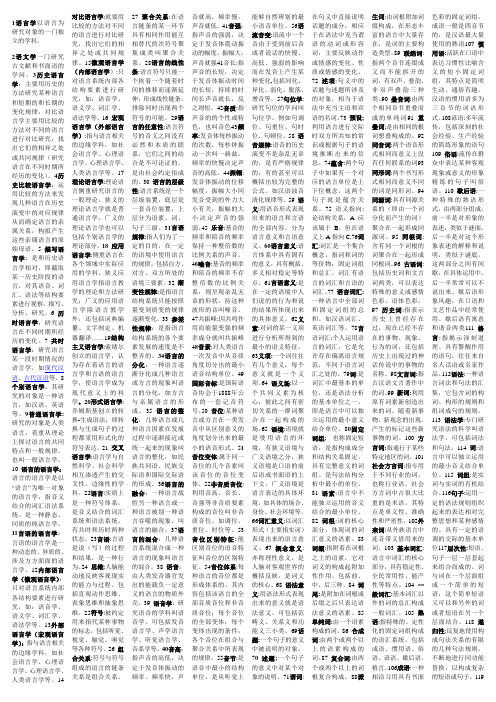
1语言学以语言为研究对象的一门独立的学科。
2语文学一门研究古文献和书面语的学问。
3历史语言学:主要用历史的方法研究某种语言和短期的和长期的变化规律,对比语言学主要用比较的方法对不同的语言进行对比研究,找出它们的相异之处或共同规律(研究语言在不同时期所经历的变化)。
4历史比较语言学:运用比较的方法来发现几种语言在历史演变中的对应规律从而确定语言的亲属关系,构拟产生这些亲属语言的原始母语。
5 描写语言学:是和历史语言学相对,即截取某一历史阶段的语言,对其语音、词汇、语法等结构要素进行观察、描写、分析、研究。
6 历时语言学:研究语言在不同时期所经历的变化。
7 共时语言学:研究语言某一段时期情况的语言学,如现代汉语、古代汉语等。
8个别语言学:其研究的对象是一种语言,如汉语、英语等。
9普通语言学:研究的对象是人类语言,着重从理论上探讨语言的共同特点和一般规律,也叫一般语言学。
10 语言的语言学:语言的语言学是以“语言”为唯一对象的语言学,指音义结合的词汇语法系统。
是一种静态、同质的纯语言学。
11言语的语言学:言语的语言学是一种动态的、异质的、涉及方方面面的语言学。
12内部语言学(微观语言学):只对语言系统内部各结构要素进行研究,如:语音学、语义学、词汇学、语法学等。
13外部语言学(宏观语言学):指与语言相关的边缘学科,如社会语言学、心理语言学、心理语言学、人类语言学等。
14对比语言学:就要用比较的方法对不同的语言进行对比研究,找出它们的相异之处或共同规律。
15微观语言学(内部语言学):只对语言系统内部各结构要素进行研究,如:语音学、语义学、词汇学、语法学等。
16 宏观语言学(外部语言学):指与语言相关的边缘学科,如社会语言学、心理语言学、心理语言学、人类语言学等。
17理论语言学:理论语言侧重研究语言的一般理论,狭义的理论语言学就是普通语言学,广义的理论语言学也可以包括个别语言学的理论部分。
18 应用语言学:侧重语言在各个领域中实际应用的学科。
语言学名词解释汇总
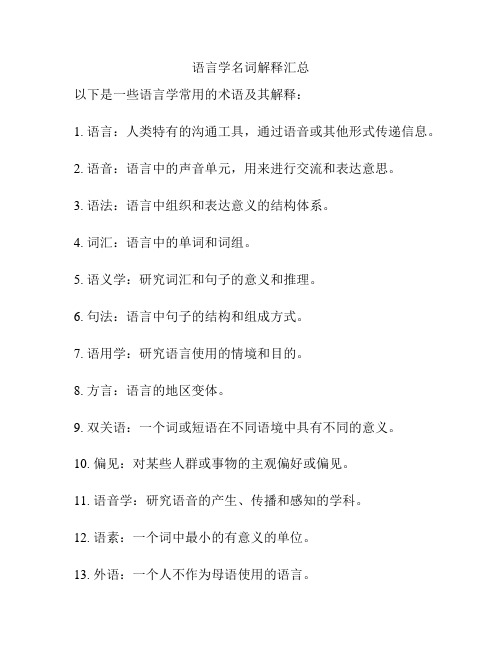
语言学名词解释汇总
以下是一些语言学常用的术语及其解释:
1. 语言:人类特有的沟通工具,通过语音或其他形式传递信息。
2. 语音:语言中的声音单元,用来进行交流和表达意思。
3. 语法:语言中组织和表达意义的结构体系。
4. 词汇:语言中的单词和词组。
5. 语义学:研究词汇和句子的意义和推理。
6. 句法:语言中句子的结构和组成方式。
7. 语用学:研究语言使用的情境和目的。
8. 方言:语言的地区变体。
9. 双关语:一个词或短语在不同语境中具有不同的意义。
10. 偏见:对某些人群或事物的主观偏好或偏见。
11. 语音学:研究语音的产生、传播和感知的学科。
12. 语素:一个词中最小的有意义的单位。
13. 外语:一个人不作为母语使用的语言。
14. 语义角色:句子中表示动作的参与者和受益者的角色。
15. 同音异义词:发音相同但意义不同的词。
16. 语体:语言在不同社会和文化环境下的变体。
17. 口音:由不同语音特征引起的发音差异。
18. 父语:一个人从小学习和使用的第一种语言。
19. 旁观者理论:社会心理学概念,指的是观察者对特定语言
和文化的理解。
20. 叙事学:研究叙述结构和故事生成的学科。
这只是一些常用的语言学术语,语言学是一个非常广泛的学科,还有很多其他的术语可供学习和研究。
(完整word版)语言学 术语翻译及术语解释

术语翻译及术语解释汇总术语翻译1.Design features of language(语言的甄别特征)Arbitrariness(任意性),Duality(二层性/二重性),Creativity(创造性/原创性),Displacement(移位性),Cultural transmission(文化传播),Interchangeability(可互换性)2. Functions of languagereferential 指称功能poetic 诗学功能emotive情感功能conative 劝慰功能phatic寒暄功能metalingual function 元语言功能ideational function概念功能interpersonal function人际功能textual function语篇/文本功能Informative(信息/告知功能),Performative Function(施为功能),Emotive Function(情感功能),Phatic communion(寒暄交谈),Recreational Function(娱乐功能),3. Phonetics(语音学),Phonology(音系/音位学); Morphology(形态学),Syntax(句法学);Semantics(语义学),Pragmatics(语用学)Articulatory phonetics发音语音学Acoustic phonetics声学语音学Auditory phonetics听觉语音学Psycholinguistics心理语言学Sociolinguistics社会语言学Anthropological linguistics人类语言学Computational linguistics计算语言学Applied linguistics应用语言学Neurolinguistics神经语言学4. Descriptive vs. prescriptive描写式和规定式Synchronic vs. diachronic共时和历时Langue vs. parole语言和言语Competence vs. performance语言能力和语言行为5. V ocal tract 声道(resonating cavities共鸣腔),pharynx咽腔, oral cavity口腔and nasal cavity鼻腔.其它的一些发音器官:lungs肺, windpipe(trachea)气管, vocal folds声带, larynx喉, epiglottis会厌,次声门, pharynx咽, uvula小舌, hard palate硬腭,soft palate软腭, alveolar ridge齿龈6.Consonants and vowels(辅音和元音)A. Manners of articulation发音方式B. Places of articulation发音位置7. Stop (or plosive)爆破音Fricative摩擦音Approximant近似音Lateral (approximant)边音Affricates塞擦音, trill颤音and tap 闪音Bilabial双唇音Labiodental唇齿音Dental齿音Alveolar齿龈音Postal veolar后齿龈音Retroflex卷舌音Palatal硬腭音Velar软腭音Uvular小舌音, pharyngeal咽音glottal声门音monophthong vowel: 单元音diphthongs双元音triphthongs三元音Lax vowels短元音Tensed vowels长元音8.Coarticulation and phonetic transcription协同发音和标音anticipatory coarticulation先期协同发音perseverative coarticulation后滞协同发音. broad transcription宽式标音narrow transcription严式标音9. minimal pairs最小对立体Phoneme音位phonemic transcriptions音位转写phonetic transcriptions语音转写phones音子allophones音位变体complementary distribution互补分布phonetic similarity发音近似性Free variation自由变体assimilation同化regressive assimilation逆同化progressive assimilation顺同化phonological rule 音系规则Epenthesis增音binary 二分的Distinctive features区别特征Endocentric and Exocentric Constructions向心结构和离心结构subordinate and coordinate从属和并列Conceptual meaning概念意义Associative meaning:联想意义Connotative meaning内涵意义Social meaning社会意义Affective meaning情感意义Reflected meaning反射意义Collocative meaning搭配意义Thematic meaning主位意义denotation: 外延意义connotation: 内涵The referential theory:指称理论Semantic triangle语义三角Sense and reference:涵义和指称Synonymy同义关系Antonymy反义关系Hyponymy上下义关系Polysemy一词多义关系Homonymy 同音/形异意关系Dialectal synonyms 地域同义词Stylistic synonyms风格同义词Collocational synonyms搭配同义词gradable antonymy 等级反义关系cover term覆盖项Marked vs. unmarked terms标记项和非标记项complementary antonymy 互补反义关系converse antonymy 逆向反义关系homophones: 同音异义词homographs : 同形异义词complete homonyms semantic components语义部分术语解释1.Design feature的定义:the defining(最典型的,起决定作用的)properties ofhuman language that distinguish it from any animal system of communication. 2.Synchronic共时:It refers to the description of a language at some point of timein history.3.Diachronic历时:It studies the development or history of language. In otherwords, it refers to the description of a language as it changes through time .4.prescriptive规定式:A kind of linguistic s tudy aims to lay down rules for “correctand standard” behavior in using language.5.descriptive描写式: A kind of linguistic study aims to describe and analyze thelanguage people actually use.6.Arbitrariness(任意性):By saying that “language is arbitrary”, we mean thatthere is no logical connection between meaning and sound.7.Duality(二层性/二重性):it means that language is a system, which consists oftwo levels of structures, at the lower level there is the structure of sounds; at the higher level there is the structure of meaning.8.Displacement(移位性): it means that language can be used to communicateabout things that are not present in our immediate communicational context.petence语言能力:it refers to an ideal speaker’s knowledge of the underlyingsystem of rules in a language.10.Performance语言行为: it refers to the actual use of the language by a speaker ina real communicational context.ngue语言: it refers to the speaker’s understanding and knowledge of thelanguage that he speaks.12.Parole言语: it is the actual speaking of language by an individual speaker.13.Cultural transmission(文化传播):It refers to the fact that the details of thelinguistic system must be learned anew(重新,再)by each speaker. Language is not transmitted biologically from generation to generation.14.Phatic communion(寒暄交谈):it refers to ritual exchanges, exchanges that havelittle meaning but help to maintain our relationships with other people.15.Phonetics(语音学): it is the study of the characteristics of speech sounds andprovides methods for their description, classification and transcription.16.V owels元音:the sounds in the production of which no articulators come veryclose together and the air-stream passes through the vocal tract without obstruction.17.Consonants辅音:The sounds in the production of which there is an obstructionof the air-stream at some point of the vocal tract.18.Phonology: it is the study of the sound systems of languages and it is concernedwith the linguistic patterning of sounds in human languages. And it studies the way in which speakers of a language systematically use a selection of these sounds in order to express meaning.19.Phoneme音位: the smallest unit of sound in a language which can distinguish twowords.20.Allophone音位变体: it refers to the different forms of a phoneme.21.Assimilation: it is a process by which one sound takes on some or all thecharacteristics of a neighboring sound.22.Coarticulation: a kind of phonetic process in which simultaneous or overlappingarticulations are involved.plementary distribution互补分布:when two sounds never occur in thesame environment, they are in complementary distribution.24.Free variation自由变体: if two sounds occurring in the same environment do notcontrast, that is, the substitution of one for the other does not produce a different word form, but merely a different pronunciation of the same word, then the two sounds are in free variation.25.Distinctive features区别特征:A phonetic feature which distinguishes onephonological unit, especially one phoneme, from another.26.minimal pairs最小对立体----- which can be defined as pairs of words whichdiffer from each other by only one sound.27.vowel glides滑音: The vowels involving movement from one sound to anotherare called vowel glides.28.Epenthesis增音:it means a process of inserting a sound after another sound.29.Substitution relation: it refers to the relation specifically between an individualunit and others that can replace it in a given sequence.30.Endocentric construction is one whose distribution is functionally equivalent, orapproaching equivalence, to one of its constituents, which serves as the centre, or head, of the whole.31.Exocentric construction: a group of syntactically related words where none ofthem is functionally equivalent to the group as a whole, that is, there is no definable center or head inside the group32.Reference: it is the relationship between words and the objects, actions orproperties that the words stand for. It deals with the extra-linguistic relationships between words and expressions and the world they describe.(具体的物质性的东西)33.Synonymy :It refers to the sameness sense relations between words.ponential analysis :Componential analysis defines the meaning of alexical element in terms of semantic components语义部分.35.Sense: it refers to the complex system of relationships that hold between linguisticelements themselves, it is concerned only with intra-linguistic relations.(概念性的东西)36.Semantics:semantics is the study of the meaning of linguistic units, words andsentences in particular.37.Homonymy: the phenomenon that words having different meanings have the sameform, i.e., different words are identical in sound or spelling, or in both.38.Antonymy:It refers to the oppositeness sense relations between words.39.Hyponymy上下义关系:Hyponymy indicates sense inclusiveness. The upperterm in this sense relation is called superordinate上义词,and the lower terms, hyponyms下义词, members of the same class are called co-hyponyms.。
语言学重要概念梳理(中英文对照版)

第一节语言的本质一、语言的普遍特征(Design Features)1.任意性 Arbitratriness:shu 和Tree都能表示“树”这一概念;同样的声音,各国不同的表达方式2.双层结构Duality:语言由声音结构和意义结构组成(the structure ofsounds and meaning)3.多产性productive: 语言可以理解并创造无限数量的新句子,是由双层结构造成的结果(Understand and create unlimited number withsentences)4.移位性 Displacemennt:可以表达许多不在场的东西,如过去的经历、将来可能发生的事情,或者表达根本不存在的东西等5.文化传播性 Cultural Transmission:语言需要后天在特定文化环境中掌握二、语言的功能(Functions of Language)1.传达信息功能 Informative:最主要功能The main function2.人际功能 Interpersonal:人类在社会中建立并维持各自地位的功能establish and maintain their identity3.行事功能 performative:现实应用——判刑、咒语、为船命名等Judge,naming,and curses4.表情功能 Emotive Function:表达强烈情感的语言,如感叹词/句exclamatory expressions5.寒暄功能 Phatic Communion:应酬话phatic language,比如“吃了没?”“天儿真好啊!”等等6.元语言功能 Metalingual Function:用语言来谈论、改变语言本身,如book可以指现实中的书也可以用“book这个词来表达作为语言单位的“书”三、语言学的分支1. 核心语言学 Core linguistic1)语音学 Phonetics:关注语音的产生、传播和接受过程,着重考察人类语言中的单音。
- 1、下载文档前请自行甄别文档内容的完整性,平台不提供额外的编辑、内容补充、找答案等附加服务。
- 2、"仅部分预览"的文档,不可在线预览部分如存在完整性等问题,可反馈申请退款(可完整预览的文档不适用该条件!)。
- 3、如文档侵犯您的权益,请联系客服反馈,我们会尽快为您处理(人工客服工作时间:9:00-18:30)。
语言学术语翻译及术语解释术语翻译及术语解释汇总术语翻译1.Design features of language(语言的甄别特征)Arbitrariness(任意性),Duality(二层性/二重性), Creativity(创造性/原创性),Displacement(移位性),Cultural transmission(文化传播),Interchangeability(可互换性)2. Functions of languagereferential 指称功能 poetic 诗学功能 emotive情感功能conative 劝慰功能 phatic寒暄功能 metalingual function 元语言功能ideational function概念功能interpersonal function人际功能textual function语篇/文本功能 Informative(信息/告知功能),Performative Function(施为功能), Emotive Function(情感功能),Phatic communion(寒暄交谈), Recreational Function(娱乐功能),3. Phonetics(语音学), Phonology(音系/音位学);Morphology(形态学), Syntax(句法学);Semantics(语义学), Pragmatics(语用学)Articulatory phonetics发音语音学Acoustic phonetics声学语音学Auditory phonetics听觉语音学 Psycholinguistics心理语言学Sociolinguistics社会语言学 Anthropological linguistics人类语言学Computational linguistics计算语言学 Applied linguistics应用语言学Neurolinguistics神经语言学4. Descriptive vs. prescriptive描写式和规定式Synchronic vs. diachronic共时和历时 Langue vs. parole语言和言语Competence vs. performance语言能力和语言行为5. Vocal tract 声道(resonating cavities共鸣腔), pharynx咽腔, oral cavity口腔 and nasal cavity鼻腔.其它的一些发音器官:lungs肺, windpipe(trachea)气管, vocal folds声带, larynx喉, epiglottis会厌,次声门, pharynx咽, uvula小舌, hard palate硬腭,soft palate软腭, alveolar ridge齿龈6.Consonants and vowels(辅音和元音)A. Manners of articulation发音方式B. Places of articulation发音位置7. Stop (or plosive)爆破音 Fricative摩擦音 Approximant近似音Lateral (approximant)边音 Affricates塞擦音, trill颤音 and tap 闪音Bilabial双唇音 Labiodental唇齿音 Dental齿音 Alveolar齿龈音Postal veolar后齿龈音 Retroflex卷舌音 Palatal硬腭音Velar软腭音 Uvular小舌音, pharyngeal咽音 glottal声门音monophthong vowel: 单元音 diphthongs双元音 triphthongs三元音Lax vowels短元音 Tensed vowels长元音8.Coarticulation and phonetic transcription协同发音和标音anticipatory coarticulation先期协同发音 perseverative coarticulation后滞协同发音. broad transcription宽式标音 narrow transcription严式标音9. minimal pairs最小对立体 Phoneme音位phonemic transcriptions音位转写 phonetic transcriptions语音转写phones音子 allophones音位变体 complementary distribution互补分布phonetic similarity发音近似性 Free variation自由变体assimilation同化 regressive assimilation逆同化progressive assimilation顺同化 phonological rule 音系规则 Epenthesis增音binary 二分的Distinctive features区别特征Endocentric and Exocentric Constructions向心结构和离心结构subordinate and coordinate从属和并列Conceptual meaning概念意义Associative meaning:联想意义Connotative meaning内涵意义 Social meaning社会意义Affective meaning情感意义 Reflected meaning反射意义Collocative meaning搭配意义 Thematic meaning主位意义denotation: 外延意义connotation: 内涵The referential theory:指称理论Semantic triangle语义三角Sense and reference:涵义和指称Synonymy同义关系 Antonymy反义关系 Hyponymy上下义关系Polysemy一词多义关系 Homonymy 同音/形异意关系Dialectal synonyms 地域同义词 Stylistic synonyms风格同义词Collocational synonyms搭配同义词gradable antonymy 等级反义关系 cover term覆盖项Marked vs. unmarked terms标记项和非标记项complementary antonymy 互补反义关系 converse antonymy 逆向反义关系homophones: 同音异义词 homographs : 同形异义词complete homonyms semantic components语义部分术语解释1.Design feature的定义:the defining(最典型的,起决定作用的) propertiesof human language that distinguish it from any animal system of communication.2.Synchronic共时:It refers to the description of a language at some point of timein history.3.Diachronic历时:It studies the development or history of language. In otherwords, it refers to the description of a language as it changes through time .4.prescriptive规定式:A kind of linguistic study aims to lay down rules for“correct and standard” behavior in using language.5.descriptive描写式: A kind of linguistic study aims to describe and analyze thelanguage people actually use.6.Arbitrariness(任意性):By saying that “language is arbitrary”, we mean thatthere is no logical connection between meaning and sound.7.Duality(二层性/二重性):it means that language is a system, which consists oftwo levels of structures, at the lower level there is the structure of sounds; at the higher level there is the structure of meaning.8.Displacement(移位性): it means that language can be used to communicateabout things that are not present in our immediate communicational context.petence语言能力:it refers to an ideal speaker’s knowledge of the underlyingsystem of rules in a language.10.Performance语言行为: it refers to the actual use of the language by a speaker ina real communicational context.ngue语言: it refers to the speaker’s understanding and knowledge of thelanguage that he speaks.12.Parole言语: it is the actual speaking of language by an individual speaker.13.Cultural transmission(文化传播):It refers to the fact that the details of thelinguistic system must be learned anew(重新,再) by each speaker. Language is not transmitted biologically from generation to generation.14.Phatic communion(寒暄交谈):it refers to ritual exchanges, exchanges thathave little meaning but help to maintain our relationships with other people.15.Phonetics(语音学): it is the study of the characteristics of speech sounds andprovides methods for their description, classification and transcription.16.Vowels元音:the sounds in the production of which no articulators come veryclose together and the air-stream passes through the vocal tract withoutobstruction.17.Consonants辅音:The sounds in the production of which there is an obstructionof the air-stream at some point of the vocal tract.18.Phonology: it is the study of the sound systems of languages and it is concernedwith the linguistic patterning of sounds in human languages. And it studies the way in which speakers of a language systematically use a selection of thesesounds in order to express meaning.19.Phoneme音位: the smallest unit of sound in a language which can distinguish twowords.20.Allophone音位变体: it refers to the different forms of a phoneme.21.Assimilation: it is a process by which one sound takes on some or all thecharacteristics of a neighboring sound.22.Coarticulation: a kind of phonetic process in which simultaneous or overlappingarticulations are involved.plementary distribution互补分布: when two sounds never occur in thesame environment, they are in complementary distribution.24.Free variation自由变体: if two sounds occurring in the same environment donot contrast, that is, the substitution of one for the other does not produce adifferent word form, but merely a different pronunciation of the same word, then the two sounds are in free variation.25.Distinctive features区别特征: A phonetic feature which distinguishes onephonological unit, especially one phoneme, from another.26.minimal pairs最小对立体----- which can be defined as pairs of words whichdiffer from each other by only one sound.27.vowel glides滑音: The vowels involving movement from one sound to anotherare called vowel glides.28.Epenthesis增音: it means a process of inserting a sound after another sound.29.Substitution relation: it refers to the relation specifically between an individualunit and others that can replace it in a given sequence.30.Endocentric construction is one whose distribution is functionally equivalent, orapproaching equivalence, to one of its constituents, which serves as the centre, or head, of the whole.31.Exocentric construction: a group of syntactically related words where none ofthem is functionally equivalent to the group as a whole, that is, there is nodefinable center or head inside the group32.Reference: it is the relationship between words and the objects, actions orproperties that the words stand for. It deals with the extra-linguistic relationships between words and expressions and the world they describe.(具体的物质性的东西)33.Synonymy :It refers to the sameness sense relations between words.ponential analysis :Componential analysis defines the meaning of alexical element in terms of semantic components语义部分.35.Sense: it refers to the complex system of relationships that hold between linguisticelements themselves, it is concerned only with intra-linguistic relations.(概念性的东西)36. Semantics:semantics is the study of the meaning of linguistic units, words andsentences in particular.37.Homonymy: the phenomenon that words having different meanings have the sameform, i.e., different words are identical in sound or spelling, or in both.38.Antonymy:It refers to the oppositeness sense relations between words.39.Hyponymy上下义关系:Hyponymy indicates sense inclusiveness. The upperterm in this sense relation is called superordinate上义词, and the lower terms, hyponyms下义词, members of the same class are called co-hyponyms.。
